OK — lace up those hiking shoes, throw your favorite snacks and a light lunch in a backpack, and don’t worry about water — we’ll have all the celestial nectar you could ever want right at our fingertips. We’re going to step back in time and follow the meandering trail blazed by Sir John Herschel almost two hundred years ago through the zig-zagging confines of the Lacertan lizard. I’ll carry the scope and eyepieces — and here, you hang on to this fifty pounds of mount and tripod. 😉
First, a few words about Sir John Frederick William Herschel, who was born into the distinctively famous shadow cast by his father, Sir William Herschel. It didn’t take long, though, before he escaped into the bright light of fame on his own merits. At the age of twenty-one he became a fellow of the Royal Society of London, based on his mathematical abilities. Thirteen years later, in 1826, he was rewarded with the Gold Medal of the Royal Astronomical Society for his double star work with James South (those stars carry the prefix Sh or SHJ), a medal he won a second time ten years later. He continued his astronomical research throughout the rest of his life, including several years of observations in South Africa, and also was involved in pioneering research in photography. Seven of Saturn’s satellites, as well as four of Uranus’ moons, have names suggested by Sir John.
For this hike, we’re going to bring along Sir John’s notes on each of these stars. It took some digging, but I finally found them buried deep in The Memoirs of the Royal Astronomical Society. For anyone interested in all the details, I’ll add the particulars and links in the first comment which follows this post.
In the meantime, a few words about Lacerta might be a good idea, too — like where in blazes is it?

Welcome to the land of the lizard, which is the English translation of the Latin noun, Lacerta. Hardly a visually stunning constellation by any means, it makes up for it with a rich collection of double stars and open clusters. (Stellarium screen image with labels added, click for a larger view)
It’s another one of those dim constellations that seems to have been sketched out to fill space occupied by only faint stars — which, in fact, is exactly what happened when Johannes Hevelius sketched it into place in the heavens in 1687. You’ll find it obscurely wedged between the west end of Pegasus and the southern edge of Cepheus, with the northern third of it parked comfortably in the Milky Way. If you’re not under dark skies, you’ll no doubt find it much easier to locate with a pair of binoculars.
Or you can just follow me with that tripod down this trail in the dark.
Geez, I love the crunch of gravel under my feet in the starlight.
First stop — h 1746!

We’re going to start at the southern tip of this lizard-like configuration and work our way north. Get your bearings at 1 Lacertae first, then all you have to do is hop two degrees north to 4.65 magnitude h 1746. (Stellarium screen image again, labels added, click for a larger view)
h 1746 (All of the John Herschel stars are listed with the prefix HJ in the WDS)
HIP: 109754 SAO: 72155
RA: 22h 13.9m Dec: +39° 42.9′
Magnitudes AB: 4.7, 10.6 AC: 4.7, 12.1 AD: 4.7, 13.1
Separation: AB: 30.4″ AC: 72.0″ AD: 195.2″
Position Angles: AB: 188° (WDS 1999) AC: 191° (WDS 1998) AD: 71° (WDS 1998)
Distance: 563 Light Years
Stellar Classification: K3
OK, let’s set up that tripod — you still have it, don’t you? — at this scenic viewpoint just a bit north of One Lacertae. We’ll drop the scope into place on it and point it north. Ready? Hit the RA switch, and — what? YOU DIDN’T BRING THE BATTERY????
Never mind ………… I’ve got the slow motion control knobs in my pocket. Let’s slip them on and …….. there we go, we’re in business now. I need a drink of nectar, though.
Ahhhhhhhhhhh …… much better.
OK, let’s point the scope north, and —– Wow! Look at that primary! That orange is spectacular!
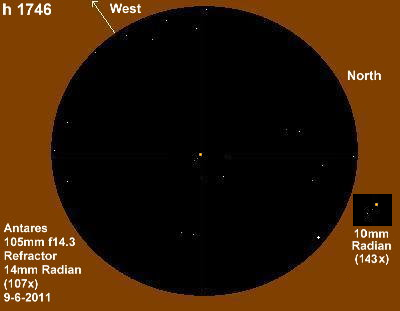
“B” and “C” are weird, but “A” is wonderfully orange! (East & west reversed to match the refractor view, click for a view without this caption)
“B” and “C” seem to be a bit difficult, though, because they’re lined up in the same direction. Now this is weird — even though “C” is 1.5 magnitudes fainter than “B”, it’s slightly easier to see. What seems to make “B” a tough one is that it’s twice as close to the glare of the primary, and it even looks as if the glow from “C” may be affecting it.
Herschel’s experience of this one was different, though. His observing notes on it state: “A third dist. 40″ nearly in line.” He later measured that third star at 60″ and estimated its magnitude at thirteen. However, I’ve noticed the magnitude estimates of this era tend to be one to two full magnitudes fainter than what are in use today. So if you reduce his estimated thirteen by a full magnitude, and combine it with his later distance measurement of 60″, that pretty much describes “C”. Obviously he had no problem in seeing it, but then he was using a twenty inch reflector, and ……….
I was using an Antares four inch f/14.3 refractor. A few nights ago I thought I could see these two stars at times in an 18mm Radian (83x), but that was with averted vision. I switched to a 14mm Radian (107x) and was able to catch a few fleeting glimpses of both “B” and “C” with direct vision, but I really needed a 10mm Radian (150x) to separate them completely. What really caught me by surprise, though, was when I thought I could detect “C” in my f/16.7 60mm refractor with a 15mm TV Plössl (67x). After I thought about it, I realized I was seeing the combined glow of both “B” and “C”, since I couldn’t distinguish them separately. Had no luck at all, though, in seeing 13.1 magnitude “D” in the larger scope.
Shall we mosey on up the path, now? I think I can see h 1786 twinkling way off in the distance, so let’s get a little closer.

The easiest way to get to h 1786 from our current location at h 1746 is to go due east four degrees to 8 Lacertae, which is located at the western tip of a triangle it forms with 12 and 10 Lacertae. In an 8×50 finder, you’ll notice 8 Lac is a stunning double. From there, turn back to the northwest and you’ll find h 1786 parked one degree away, right next to the slightly brighter 6.5 magnitude HIP 111355. (Stellarium screen image with labels added, click to enlarge)
h 1786 HIP: 111429 SAO: 52155
RA: 22h 34.5m Dec: +40° 46.5′
Magnitudes: 7.0, 9.6
Separation: 43.4″
Position Angle: 225° (WDS 2003)
Distance: 945 Light Years
Stellar Classification: A5
OK, we have to take a side trail now, and since it’s less used, we better pay attention in the dark or we’ll get lost up here. Hey, look, there’s a junction at 6.2 magnitude HIP 110849 with a sign that points to 5.9 magnitude HIP 111259. Let’s follow it for a ways and ………. well, look at that, the trail ends here! But I think we’re in luck — here’s a knoll we can set up on that has a clear view to the east and north.
Now if you look due east, you’ll see something that’s certain to electrify your erfle. That pair of white stars over there is 8 Lacertae — actually, if I remember correctly, there are five stars in that system — but the first time I cast eyes on the two white ones, it really made my Plössls palpitate. Greg wrote it up here, so you might take a peek at that for a moment. Meanwhile, I’ll point the scope to the northeast and get h 1786 centered in the eyepiece.
There, that’s better. Take a look.
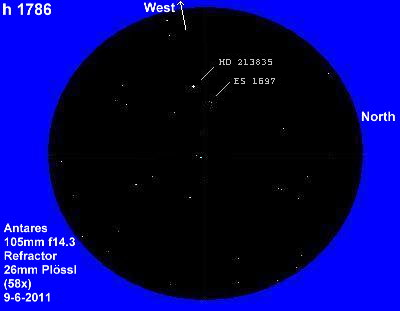
A slight tinge of primary blue in a faint field, with a bonus — ES 1697 — to the west. (East & west reversed, click to lose this caption)
Now the thing I like about this pair of stars is that slight tinge of blue in the primary, which helps draw your eye to this faint field. Well, most of the field is faint — you’ll notice 6.7 magnitude HD 213835 about halfway across the field to the west, and if you look carefully, just before you reach it, there are two faint stars parked very closely together. Those are ES 1697, magnitudes of 10.0 and 10.7, separated by 2.9 seconds of arc. The Washington Double Star Catalog (WDS) shows the position angle at 340 degrees, but that observation was made in 2001, and it looks to me like the measurement might be out of date since the secondary is at almost exactly the same angle as that of h 1786. At any rate, it was discovered in 1917 by Thomas Henry Espinall Compton Espin (1858-1934) — known as T. E. Espin to his friends — a British observer who discovered over 2500 double stars using seventeen and twenty-four inch Calver reflectors. (That information comes from the Webb Society Deep-Sky Observer’s Handbook: Volume 1, Double Stars: 1986, p. 70)
I had an f/16.7 60mm refractor out here last week pointing at h 1786, and it actually served up a very neat, crisp view in a 20mm TV Plössl (50x). And of course, it was a pleasant sight in the 105mm f/14.3 refractor, especially with the wider view I had in a wonderful old 26mm Celestron Plössl (58x) that I used to make the sketch.
Herschel estimated the magnitudes of these two stars at “8-9” and “11” — again, fainter by a couple of magnitudes than current measurements. For a position angle, he came up with 228 degrees — close to the 2003 WDS measurement of 225 degrees — and for their separation, he ended up with 30 seconds of arc, a bit tighter than the 43.4″ shown by WDS.
OK, time to move on to h 1735, so let’s turn around and follow the trail back to h 1746.
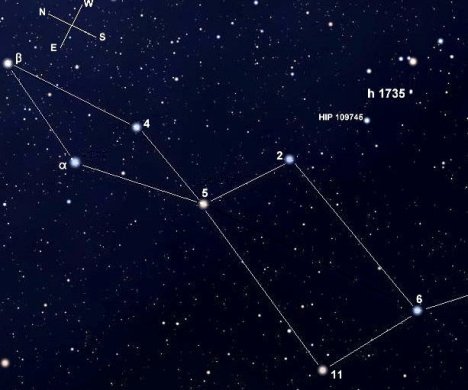
To get to h 1735, you can either go back to h 1746 and move about three degrees northeast to 6 Lacertae, or you can just hop two degrees northwest to 6 Lac from h 1786. Once you’re at 6 Lacertae, another northwest hop of four degrees will get you to 2 Lacertae. From there, leap two degrees to the west while leaning to the south to reach 5.5 magnitude HIP 109745. Continue in that direction another degree and you’ll come down at h 1735. (Stellarium screen image, labels added, click to enlarge)
h 1735 HIP: 109354 SAO: 51698
RA: 22h 09.3m Dec: +44° 51′
Magnitudes AB: 6.7, 9.7 AC: 6.7, 13.5 AD: 6.7, 6.8
Separation AB: 27.3″ AC: 43.0″ AD: 109.0″
Position Angles AB: 109° AC: 138° AD: 286° (All WDS 2006)
Distance: 652 Light Years
Spectral Classification: B9
Hey, look! Here’s another side trail, and the map shows it leads to 6 Lacertae. Let’s take a stroll down it. Duck, though, there’s a lot of stardust clinging to these old tree limbs — looks like no one has used this trail for a while. Watch out for those luminescent slithering lizards, too.
Ah, here we go — the blue-white beauty of 4.5 magnitude 6 Lacertae already — boy, that was a quick little detour! Might want to shield your eyes from the glow so you can see this trail in the dark. Now, let’s wander on up this well-worn path to 2 Lacertae, another 4.5 magnitude blue-white dazzler, and set up at the junction to HIP 109745. Wow, what a night — look at the Milky Way glowing in the dark up there to the north!
Ease the tripod down again — here’s the scope — and let’s point it southwest — yep, right there, just past HIP 109745.

“B” has just a slight eye-catching touch of blue, and “A” and “D” are unmistakably white. (East & west reversed, click for a caption-less view)
This one you can easily split in an 8×50 finder — what you see there is “A” and “D” — which helps to locate it. I haven’t been able to wriggle “C” loose from the glow of its brighter companions — it’s too darn faint at a magnitude of 13.5 — but the other three stars offer such a beautiful sight that I haven’t really missed it.
Herschel apparently didn’t consider “D” to be part of this system, at least at the time of his initial look at them. He describes three stars with magnitudes of “7-8”, “9-10”, and “15.” He may have gone back and made a later observation, though, but I haven’t found it yet.
You can see that “A” and “D” are a definite white, and “B” has just a slight eye-catching touch of blue in it. This is an interesting multiple star, not only because of the way the three visible components are lined up, but because “D” is just a tenth of a magnitude fainter than the primary. But “B” is obvious, too — I picked it out with no problem last week in the 60mm f/13.3 Lafayette refractor I have mounted on my AR-5. It was a breeze in a 20mm TV Plössl at 40x.
Speaking of breezes, it’s getting a bit cool up here. Better head on up the trail — we can warm up on the zigzagging switchbacks between here and h 1741.
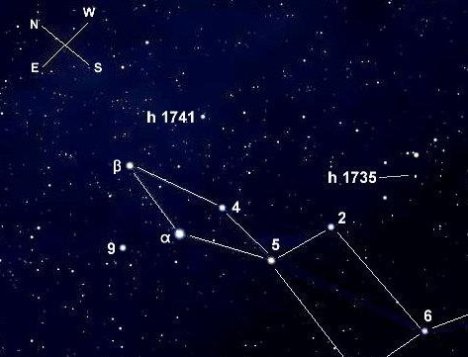
To get to h 1741, start at 2 Lacertae, move two degrees east to 5 Lacertae, two degrees north to 4 Lacertae, bend slightly to the northwest and continue for a bit more than two degrees to reach h 1741. You can see that it and 4 Lacertae form a triangle with Beta (β) Lacerate, which also helps to locate it. (Stellarium screen image with labels added, click to enlarge)
h 1741 HIP: 109521 SAO: 34143
RA: 22h 11.2m Dec: +50° 49′
Magnitudes AB: 5.4, 10.4 AC: 5.4, ??? AD: 5.4, 10.0
Separation AB: 36.0″ AC: 62.1″ AD: 73.6″
Position Angle AB: 286° AC: 271° AD: 271° (C: WDS 2000, A & B: WDS 2008)
Distance: 179 Light Years
Spectral Classification: All A5
OK, here we go, let’s zig to 5 Lacertae, then zag to 4 Lacertae, and set up the tripod and the scope again. We’ll peer across the valley and peek at h 1741.

All white, but not alright ….. “C” is hiding somewhere in the shadows. (East & west reversed again, click to lose this caption)
Now, this one is all white — all white, but not alright. That’s because the mysterious “C” star — the one in the data line above with question marks for a magnitude — seems to project a shadowy presence. It’s in a very inconvenient spot for detection — lined up in the same position angle as “D”, and only 11.5 seconds of arc from it — and not knowing it’s magnitude, I can only guess that it’s at least less than “D’s” 10.0 magnitude. At any rate, it seems to be causing some elongation in “D”. I’ve tried to pry these two apart several times, but haven’t had any luck in getting any more than that elongated form. According to the WDS, “D” was added in 1902, and the elusive “C” came later, in 1923.
But ….. Herschel’s notes state he saw another pair of stars, in addition to “B”: “Two more precede. Nearest 12m; farthest 10m.” I’m not sure what the “m” in those distances mean, but they do indicate a closely separated pair of stars, and his “precede” puts them on the west — which is the correct — side of the primary. So it looks like he saw both of them.
At any rate, this gem of Sir John’s stands out well from the sparsely dim field it calls home. Actually, the field is really fairly dense, but it’s the dimness of the stars that make it appear sparse. There are a lot of interesting patterns to be seen in all those tenth, eleventh, and twelfth magnitude field stars, though. As I made the sketch shown here, I found myself getting lost as I followed their meandering paths right on out of the field of view shown in the sketch. That wasn’t particularly hard to do, since I was using an undriven mount — I just let them drift and went along with them, until I felt a tug from the primary and got pulled back to the center of the field.
Ready for the last leg of this hike along the Lacertaen Trail? Let’s wander on up to Beta (β) now.
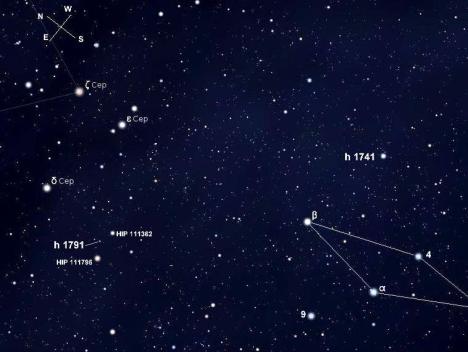
The easiest way to approach h 1791 is from Delta (δ) Cephei, another stunning double. You’ll find that h 1791 is located about a degree and a half to the south, nestled between 5.1 magnitude HIP 111795 and 5.7 magnitude HIP 111362. (Stellarium screen image with labels added, click for a larger view)
h 1791 HIP: ????? SAO 34602
RA: 22 35.7m Dec: +56° 52′
Magnitudes AB: 7.7, 9.7 AC: 7.7, 11.0
Separation AB: 17.2″ AC: 89.6″
Position Angle AB: 59° AC: 141° (Both WDS 2006)
Distance: ?????
Spectral Classification: G0
Beta (β) is an easy hike of about two and a half degrees due north along another well-worn trail, so let’s huff and puff our way uphill for a ways. Here we go ….. man, I’m glad we’re near the end of this little hike, my feet are getting sore — how about yours? One more bend in the trail up here, and ……… uh oh ………. looks like we’ve got a problem ………… we’re at the end of the Lacertaen trail ……….. .
But look, there’s a bench someone was thoughtful enough to put here. Let’s have a seat, rest our feet, and take a long sip of that luscious stellar nectar that’s bubbling up out of this Milky Way spring. Here’s a cup, just scoop some out of the air there, and ……. mmmmm, mmmmm — man, that’s good stuff!
Now, we could wander off and find a connecting trail that would take us to Delta (δ) Cephei in a couple of light years, or we could just stare across this dazzling pool of stars gleaming in the Milky Way until we find h 1791. I vote for the last idea, especially since the nectar is beginning to make my legs weak. Isn’t that good stuff? What? Yeah, I hadn’t thought of that — Nectar of the Gods it is!
Let’s aim the scope across to the northeast, get 5.7 magnitude HIP 111362 in sight, and then nudge it to the east and h 1791 will slide into our eyepiece. And hey, look over there —– that magnificent star in the background is the delectable Delta (δ) Cephei — mouth-watering, isn’t it? I love the contrasting yellow-orange and blue of that pair — gotta come back to that one.
Anyway, here we go — and there it is! Wow! Even though it’s a bit dim, this is beautiful.

A bit dim, a bit beautiful, a bit compact …….. even a bit like Delta (δ) Cephei. (East & west reversed, click … to … lose this caption)
It’s a compact object that stands out in a very full field of 11th and 12th magnitude stars. It’s helped quite a bit by its colors. The primary is a pale gold, and “B” is a distinctive bluish-white — kind of a weak imitation of Delta (δ) Cephei, now that I thing about it. And “C” — well, “C” is just out there to be seen, floating off in the distance far enough away that it looks like it might wander off some day — or night.
When Herschel looked at this one, he estimated the magnitudes of “A” and “B” at eight and nine. The separation and position angles he came up with are very close to the 2006 WDS data: sixteen arcseconds and sixty-four degrees — but he didn’t include “C” at all in his notes, although it’s likely he saw it.
There are so many stars in this field of view that when I made the sketch shown here, I resorted to using an 11mm TV Plössl to narrow the field to a more manageable level. But with a wider field of view — I used an 18mm Radian (66x) last week in the AR-5 — I was able to pull the much brighter HIP pair, 111362 (magnitude 5.7) and 111795 (magnitude 5.1), into the view. They tend to overwhelm the background, though, so I lost them again by narrowing the field with a 24mm Brandon (49x), which also brought out quite a bit of background nebulosity. Kind of eerie, actually.
And then there’s that line of tenth and eleventh magnitude stars trailing off to the southeast and ending in a triangle, which is really very intriguing. Kind of tempting to just follow them and see where they lead.
But we’ve covered quite a few light years tonight, so why don’t we just stay put for a while. The view is simply superb, my feet need a break, and this nectarius elixir is exhilarating ——- so I think I’ll just sit here and let all of this sink in until it fades into the weak light of dawn. Stick around — the rest of the night is a feast just waiting for our eyes to inhale it.
Filed under: 4. Choose a Constellation:, Lacerta |


A couple of things need to be added here. First of all, most of the stars discussed above are on the faint side — h 1735 being the main exception — so they’re seen best when the moon isn’t interfering. Second, this area of the sky is so full of clusters and wisps of nebula that a dark sky background is a necessity to get the most out of it.
When I first noticed the five stars in Lacerate with the “h” designation, I thought it would be fairly simple to track down Sir John Herschel’s original observations of them. Simple it wasn’t, mainly because they were somewhere other than where I expected. I knew his observations had been published by the Royal Society of London, so my first search was in their journal, Philosophical Transactions. I didn’t find what I was looking for there, but I did discover the joint catalog of observations that Herschel published in 1824 with Sir James South, and I also found South’s catalog published in 1826, both of which I had been looking for anyway.
Finally I tracked down a reference to The Memoirs of the Royal Astronomical Society, a very misleading title, which was the journal in which papers submitted to the RAS were published. Sir John Herschel’s observations were published in several different issues, beginning in 1826. Fortunately, all of those issues are in the public domain now, and can be viewed online here.
Downloading any of that information requires logging in to the site, which requires registering with the University of Michigan. I found that allowed me to download what information I wanted a page at a time. Every attempt to download entire issues of the journal was turned down, which is rather frustrating since it’s in the public domain.
At any rate, for those interested, what follows are the volumes and page numbers of Sir John Herschel’s observations. The introductory material to those observations makes for fascinating reading.
h 001 to h 321: Volume 2 (1826), p. 459. The observations run from pages 475 to 485.
h 322 to h 616: Volume 3 (1827-1829), p. 47. Observations are on pages 52 to 63.
h 617 to h 1000: Volume 3 again, p. 190. Observations are on pages 201 to 213.
h 1001 to h 1937: Volume 4 (1830-1831), p. 331. Observations are on pages 335 to 378.
h 1938 to h 3241: Volume 6 (1833), pp. 1 – 73, with comments on pp. 74-81.
h 3242 to h 3346: Volume 9 (1836), pp. 193-203, comments on p. 204
h 3347 to h 5449 are on pp. 171 to 242 of Herschel’s Results of Astronomical Observations Made During the Years 1834, 5, 6, 7, 8 at the Cape of Good Hope, published in 1847. The book is in the public domain and can be found here on Google.
h 5450 to h 5533: Volume 38 (1871), p. 1, observations are on pp. 5 to 16.
It’s fascinating to read about the difficulties and challenges faced by 19th century observers, such as Herschel, South, and Admiral Smyth. More than once I’ve found myself smiling as they describe some temporary frustration which is only all too familiar. In a lot of respects, things today are not all that different than they were then.